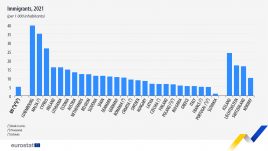
In 2021, there were an estimated 2.3 million immigrants coming to the EU from non-EU countries and about 1.1 million people from the EU who emigrated to a country outside the EU, Eurostat said in a statement. Data show “an important increase compared with 2020 when an estimated 1.9 million immigrants” came “to the EU from non-EU countries and about 956 thousand people emigrated from the EU to a country outside the EU”. In addition, 1.4 million people previously residing in one EU country migrated to another EU country in 2021 (1.2 million in 2020). Germany reported the largest total number of immigrants (874,400) in 2021, followed by Spain (528,900), France (336,400), and Italy (318,400). Germany also reported the largest number of emigrants in 2021 (543,200), followed by Spain (380,800), Romania (216,900), and Poland (201,600). In total, 23 EU Member States have a higher immigration than emigration rate in 2021. In Croatia, Greece, Latvia and Romania, by contrast, the number of emigrants has been higher than the number of immigrants. EU countries, with the exception of Greece, Cyprus, Portugal, Slovenia and Slovakia, experienced an increase in the total number of immigrants in 2021 compared with 2020. Between 2020 and 2021, the largest increase in relative terms was recorded in Latvia (44%), Romania (34%), and Malta (31%). Slovenia, by contrast, reported the largest decrease (-35% of immigrants between 2020 and 2021). In 2020, by contrast, almost all EU countries, with the exception of Finland, Lithuania and Slovenia, reported a decrease in the total number of immigrants compared with 2019.
